Ever since I was just a boy I’ve been more than a little bit obsessed with an old, abandoned railway line skirting the southern edge of the Mile Cross estate between the back of Sloughbottom Park and the River Wensum. In more recent times we’ve come to know this former railway as a footpath/cycleway named the “Marriott’s Way” and if you’ve ever wondered why the footpath is named this way, read on.
 William Marriott ©Northmetpit
William Marriott ©Northmetpit
William Marriott was Chief Superintendent and then Traffic Manager of The Midland and Great Northern Railway (formerly Eastern and Midlands Railway) for 40 years between 1884 and 1924. William was a highly-respected engineer, rising above his peers from a very young age and in his early years of work on the railways became the youngest engineer on a public railway in that era. One of Marriott’s biggest feats was helping to build the M&GN rail network on a tight budget and in doing so becoming a much admired and fondly-remembered figure of authority by all of his staff. In fact, so well remembered was William that he was often referred to as ‘The Father of the M&GN”. William Marriott’s local fame is also why the fairly new village, built between Drayton and Taverham and straddling the former track bed was named “Thorpe Marriott”.
William had a brilliant mind for engineering and was always thinking of inventive ways to cut costs. One of his plans was to cut down on the maintenance costs of the railway furniture that was in constant need of repairing and replacing. There were miles and miles of wooden fence-posts, mile-marker posts, gradient posts, signage posts, signal posts, signalling anchors and even bricks for upgrading bridges and gatehouse. Most of these items had a fairly short life-span, meaning that they were expensive to constantly maintain or replace yet vital to the smooth running of a complex railway system. William’s idea was to replace all of these items with ones made from pre-cast, steel-reinforced concrete, items that would be designed to last for decades, not years. His cost-cutting innovations here meant the he went one to be one of the leading figures in pre-cast, steel-reinforced concrete. So good were these replacement items that most of them can still be found to this day a century after they had been replaced. Most of the fence-posts remain along with a handful of the mile-posts (the ones that weren’t stolen after closure) and even the massive signal posts tend to be still laying on the ground where the demolition crews left them. William had even managed to sell some of these items to his rivals, creating a much-needed injection of cash into the frugal M&GN coffers. Being a shrewd old dude, Marriott had patented his idea, meaning that after the nationalisation of the railways, British Rail were too tight to pay for the copyrights and the MRC-branded, steel-reinforced railway furniture retired with Marriott when he said goodbye to a life on the rails.
What this means for geeks like me is that the remaining items dotted along the Marriott’s Way (and beyond) are mostly dated and often have the ‘MRC’ (Marriott/Melton Railway Concrete) patent stamp hidden on them somewhere. A good place to find a local example of this can be seen below the 1923 bridge carrying the later-added Mile Cross Road over the track-bed next to Andersons Meadow, where the fence posts either side are dated to tie up with when the bridge interrupted the track boundary, 1920 on one side and 1922 on the other.  “MRC” and “9/10/20” stamps on a fence post at Mile Cross Road. These fence-end posts pre-date the estate!
“MRC” and “9/10/20” stamps on a fence post at Mile Cross Road. These fence-end posts pre-date the estate!
Another example of the longevity of these replacement items can be seen if you drive along the coast road between Sheringham and Weybourne where the NNR rails run right next to the road; a 40ft tall concrete ‘distant’ signal, still stands proud and in good condition even after taking a century of battering from the relentless North Sea weather.
Should you follow the footpath named after William Marriott from start to finish it would take you along the former track-bed from it’s starting point near the inner-ring road by the unofficially-named ‘Halfords roundabout’, through Anderson’s Meadow, under Mile Cross bridge, behind ‘sloughie’ (Sloughbottom Park to those not from the ‘cross’) and then out into the beautiful Norfolk Countryside in a north-westerly direction all the way up to Reepham, before diverting from it’s original northerly route and heading around the Themelthorpe Curve to head eastwards on to Aylsham. However, if you did just that and followed this 26-and-a-bit-mile footpath out to Aylsham, you wouldn’t get to see the full picture of my somewhat bizarre obsession or learn how naming the whole path after Marriott doesn’t entirely make historical sense, so read on if you want me to bore you with a little more detail.
 Postcard of City Station from Wikipedia.
Postcard of City Station from Wikipedia.
This particular M&GN branch line was built in the early 1880’s and went from Norwich City all the way up to the impressive railway works at Melton Constable (actually it was built the other way…), which grew out of a tiny, almost abandoned settlement going by the name of Burgh Pava, located way out in the wild frontiers of Norfolk. Melton Constable Railway Station and its yard were effectively built as a cross-roads where the line heading north from Norwich and out to the coastal destinations such as Cromer, Sheringham and Mundesley met the line running west-to-east from the Midlands and out to other famous coastal destinations such as Hemsby, Caister and Great Yarmouth.
Now this is where it gets a bit geeky; or is that ‘even more geekier’? I can’t really tell any more. The Marriott’s Way only follows William Marriott’s M&GN line as far as the tiny parish of Themelthorpe, just north-west of Reepham, before doing a 180 degree turn around a later-added railway curve known as the Themelthorpe Curve. This curve was added by British Rail in September, 1960 after the M&GN had been closed to passengers, joining the line to another already-closed Great Eastern Railway (GER) line running between Fakenham and Aylsham. The curve was put in to cut the distance of freight running from Norwich City to Norwich Thorpe – which were only about a mile apart as the crow flies, yet a journey of about 60 miles before the addition of the curve, a route remembered fondly by the freight drivers as the ‘Round the World’ trip. The GER were the biggest rival to and a far larger company than William Marriott’s M&GN and this is why it seems a little bit strange that the whole footpath, was named after Marriott. Perhaps it’s a testament to his popularity that it’s his name being used for the remnants of one of his biggest rivals.
Oddly, I have little to no interest in the abandoned railways of the GER (Great Eastern Railway). I can’t really put my finger on why this is, but maybe it’s because I’m not really a railway buff (although I am heading that way) and I suspect it’s because the M&GN parts of the former Norfolk Railways have as deep-rooted connection with my childhood psyche and it’s actually that which lures me in. As I’ve learned more and more about the history of the M&GN Railway Company I’ve come to the conclusion that this little railway company (Norfolk’s very own underdog) was oozing with charm, a charm that even though it closed all those years ago, it still seems to have to this day in the bits and pieces of it left, seemingly forgotten about, all over the Norfolk Countryside. This probably also explains why I’m constantly attracted to the (M&GN) North Norfolk Railway like a moth to a flame but have rarely ventured over to look at the (former GER) Mid Norfolk Railway. Thankfully though, the more research I’ve carried out the more I’ve realised that it’s not just me to have picked up on the former M&GN’s mysterious charm and it seems to be the reason that even after the railways were nationalised in 1948 it was still fondly referred to as the M&GN (or ‘The Joint’) and not British Rail, right up until it was completely closed for good in 1969.
Most of the M&GN had avoided the ‘Beeching cuts’ mainly because they were being closed before that had even happened, but there was a small remaining section running from Melton to Roughton (Cromer) that did eventually fall foul of his infamous axe. The tracks of the M&GN were rapidly pulled up shortly after closure and the countryside was as all-to-quick to set about reclaiming what had been taken from it all those years ago in the name of Industrial revolution. Having been born in the latter part of the 1970’s, I never actually got to see any of the M&GN in action with my own eyes, which is why I’m always excited to see photographs of how it all looked back in the day. This in turn probably fanning the flames of my obsession with it all the further.
The obsession started in the 1980’s when I first became aware that the path I’d so often been walked along as a child and also formed part of the infamous Mile Cross Middle School cross-country course was in fact an abandoned railway line. My mum had told me about the former Hellesdon Station and some of my classmates were adamant that they were being chased by a Ghost Train as we ran along a short section of the line behind Sloughbottom Park. As we Mile Cross kids grew a bit older and the ‘Mountain bike’ become the new thing to own, my friends and I would often use this pathway as a fairly safe passage to venture further and further away from home and out into the open countryside on our doorstep. We mostly cycled up to the River Tud at Costessey’s ‘Red Bridge’ or on to Costessey Mill for a swim. We sometimes even ventured out as far as Drayton, but I never really got explore the line any further than that and my young mind had often wondered what was to be found further out past Drayton.
Not only did the footpath open up access to the countryside for our young and inquisitive minds, it could also be used as handy short-cut to lead you almost directly into the heart of the city centre, although this was complicated at the start by the fact that for a brief spell in the early 1980’s there was no bridge spanning the Wensum. The beautiful Victorian A-Frame Bridge connecting City Station to Mile Cross had been removed by the Council due to apparent metal fatigue; however, during our FONCS research we’ve become a little suspicious of this explanation, suspecting that it’s removal was an excuse by the Council to stop it being used for criminal activities. The old track bed wasn’t disrupted for too long though and after a few years, a temporary wooden bridge had been installed to encourage people to start using this as a footpath again. The replacement bridge on the footings of the demolished A-Frame.
The replacement bridge on the footings of the demolished A-Frame.
As a kid who was regularly walking and cycling back and forth along the Marriott’s Way I had become increasingly aware that there were all sorts of bits and pieces of railway-related infrastructure still poking out from the weeds and hiding in the bushes; there were concrete sleepers still sitting in the ground here and there, an entire blue-bricked floor hiding in the bushes near Halfords, the two remaining beautiful Victorian Iron ‘A-Frame’ bridges (like the one now missing at City) and of course the bits of platform sticking out of the ivy at Hellesdon. With my friends seemingly oblivious to it all I never brought it up and I never really got the chance to stop to investigate them further, so my curiosities had to be locked away in a little storage cupboard hidden in one of the dusty corners of my mind.
This cupboard was to remain shut, gathering dust until adulthood and in 2003 I moved in to a new house on the former shoe factory site off Drayton Road. The site was connected to the Marriott’s Way by a tiny, unofficial footpath that came out near to Dolphin Bridge and this handy little short-cut meant that it made sense for me to start to using the Marriott’s Way again, this time to commute into the city centre.
As I began cycling to and from work along the former track-bed here the rusty old latch on that cupboard door finally gave way and the door sprung open again, the contents of which (my childhood curiosities about the old railway) spilling out all over the floor of my already-cluttered mind. I could still see the bits and pieces of the railway infrastructure sticking out the undergrowth, although in the time it had taken me to progress to adulthood, so had the young trees and bushes either side of the former track-bed. Nature had been hard at work and the empty, almost industrial feel to the Marriott’s Way of the 1980’s had been maturing into a green corridor, particularly here at the City Station end.
At the same time a very basic, early Google Maps was being launched, giving me the ability to be able trace the former track bed as it made its way out of City and across the Norfolk landscape. I’d started printing out dozens of A4 sheets of the maps and began sticking them to one of the walls in my spare room/office. It must have looked like the world’s geekiest wallpaper, but it helped me to understand the layout of the M&GN as it made a big, industrial cross on the Norfolk landscape, centred on Melton Constable. Unsurprisingly, this unique ‘wallpaper’ wasn’t allowed to stay on the wall for too long as the room was to be needed for my growing young family, but thankfully with the rise of the smartphone, Google maps became something that you could keep in your pocket and If you look at my Google maps today you can see the extent of the former M&GN, and the extent of my geeky obsession.  A screen-grab from my Google maps showing points along the M&GN.
A screen-grab from my Google maps showing points along the M&GN.
What had started out as a minor obsession with a little piece of railway history close to home had now been upgraded to county-wide obsession with something ceasing to exist over half a century ago. Seeing as I was now armed with an expanded knowledge of the layout of the former M&GN track-bed, a car and a digital SLR, I had a new excuse to go out for a Sunday drive and a walk, deep out into the Norfolk Countryside to trace and explore those long-lost rails from ground-level to see what I could find. The more I explored, the more I was to find and the more interesting it became. Each exploration would lead me further out into the wilds of Norfolk, some of it still brilliantly remote even by today’s standards, these often-long and winding journeys eventually leading me right up to the Norfolk Coast, which happens to be another one of my favourite places to be. Just as it had done for those Victorian Holiday seekers, the M&GN had connected me to – and helped me fall in love with – the beautiful Norfolk Coastline, and all the lovely remote bits in between here and there.
In another rather fortunate stroke of timing, the Internet was now becoming an increasingly-popular tool for research, as well a brilliant form of media that enabled more and more people to start sharing their images, both old and new, in turn pouring even more fuel onto my recently re-lit burning obsession with local history. I was now starting to come across old photographs of the M&GN that as a curious child of the 1980’s I could have only ever dreamed of seeing.
I no longer had to try and imagine what these old, overgrown pathways, lines of trees, broken railway embankments and cuttings, and in some cases now open fields looked like back in the heyday of rail travel, I could simply hold up a picture and actually see it for how it was. For me it was like I was a kid in a sweet shop (or as John Batley – another Mile Cross lad – says: “like a dog at the beetroot”) and as I was beginning to find more and more pictures of the former railways; it also happened to coincide rather nicely with a time when a new form of photography called ‘re-photography’ or ‘ghost images’ was then becoming popular.
This ‘ghosting’ technique involves taking a photograph from very the same spot as where the original photographer had stood all those years back and then merging the two images together in photo-editing software (such as Photoshop) to help create/recreate a window into the past. I stumbled across this style of photography when a friend of mine started applying the technique to images taken during the infamous ‘Baedecker blitz’ which witnessed Norwich being mercilessly pounded by German Bombs back in April 1942. I was instantly hooked by the images and needed to try out the technique for myself. What better subject to focus on (sorry!) than the former M&GN railways as they left Norwich via Mile Cross and out into the Norfolk countryside.
My “M&GN Ghosts” series of Photographs was born and what had originally been something created just to scratch a peculiar itch for me became an increasingly-popular project, the pictures started going viral and were picked up on by the National and Local Press, the Heritage Railway Community and many other ‘popular trend’ websites such as mymodernmet.com. I even agreed to take part in a rather bizarre TV interview with Helen McDermott and Darren Eadie on Mustard TV. Mustard TV! This was my moment of fame and my ghost images were witnessed by a massive TV audience of about 38… ahem, moving swiftly on. I’ve also been asked to display the images at countless exhibitions across the county, and at one particular event leading me to a chance meeting with a former M&GN fireman, who had starred in one of the more amusing Ghost images I’d created close to home; The Wensum Dipper, which I wrote about a few years back here: David Jackson Rides the Wensum Dipper. I love this story and it is still up there as one of my all-time local history favourites.
So what better way to recreate a journey along these long-lost railways than to explore it on foot, taking photos as you go, with your head in the past and your camera in the future? Below is a collection (and a journey) of some of the ghost images I have created over the years starting right here in Norwich and working my way out into rural Norfolk before ending up at the coast.
I hope you enjoy looking at them as much as I’ve loved getting out there and creating them, all whilst helping me to reconnect with my childhood, the past and the present all in one go. I’ll warn you now, this particularly picture-heavy:
The Original City Station, the day after it was targeted in a German raid. 
Where the original building would have stood, now the inner-link. 
The less-grand, post-war replacement… 
…and again after closure to passengers.
John Batley digging out Platform 1 during the early days of FONCS. 
The passenger side of the reconstructed ticket office. 
Looking back towards the ticket office after closure. 
The final day of passenger travel, February 1959. 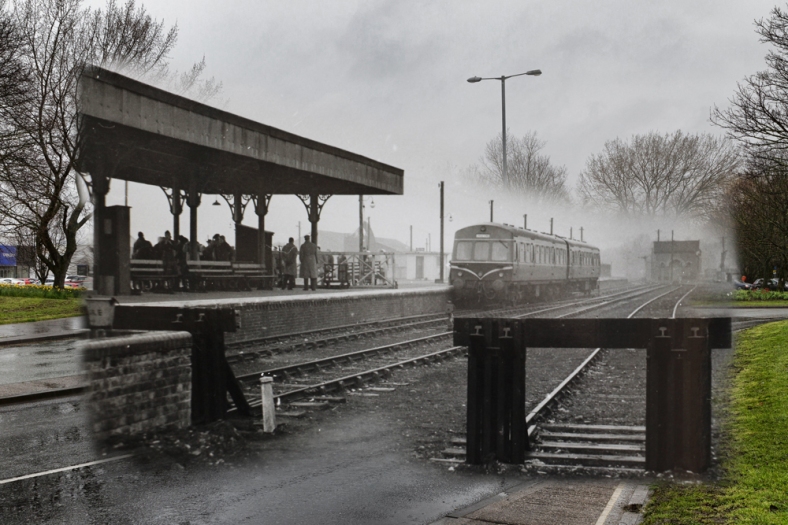
A steam loco taken from a similar position to the above. Barn Road. 
Looking back from the roundabout on a cold winters day in the later years of rail travel.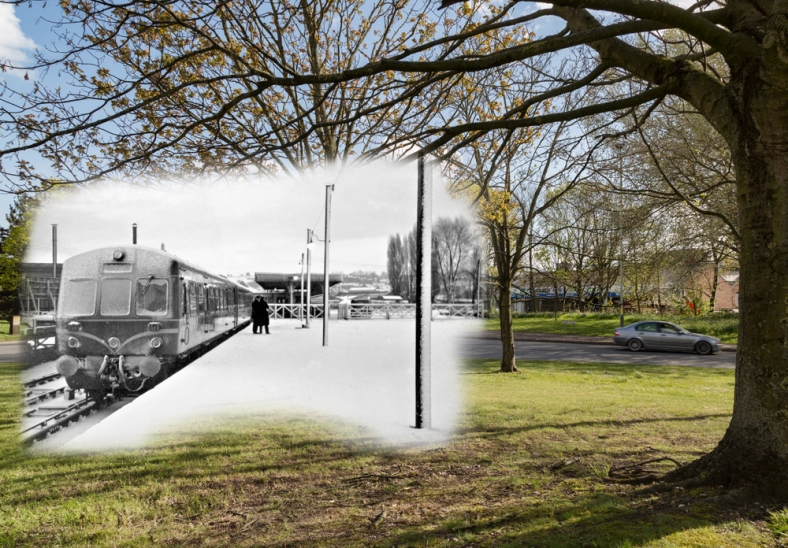
John Batley standing in the past.
A young Ethan, stood in the past.
An ‘M&GN Special’ visits the Station after closure.
The same special, only in colour and our recently-unearthed platform one.
The last passenger steam to ever leave City Station.
The view from the end of P1 looking towards Mile Cross.
FONCS, hard at work uncovering the lost platform 1.
The Mess Room and engine shed seen from a train at the end of Platform 1.
The ‘M&GN Special’ taking on coal and water at the recently-exposed coal dock.
The same again for the last ever passenger loco.
An earlier shot showing a loco between the coal dock and water tower.
Looking North from City along the start of Marriott’s Way.
Norwich City’s post-war replacement engine shed that now lives at Weybourne:
And an earlier engine inside the original shed.
Looking back the other way, before the shed’s floor was exposed once more.
Behind the shed is the later-added 60ft turntable’s remains, now hidden in Train Wood.
One last look back at City from Barker Street in the final days of freight (1960’s).
One of the final freight services crossing the Wensum on way to the yard at City.
As we leave City we encounter the River Wensum and the first of the A-Frames.
A closer look at that sadly-missing A-frame.
Crossing the Wensum usually went fairly smoothly. Oops!
Some may remember this footbridge still taking you up and over the former railway.
Mile Cross Road 1961/2021:

Looking back towards Sloughbottom from Sweetbriar Road.
The line crosses the Wensum once more as we approach Hellesdon Station.
Looking towards Hellesdon Station through the non-existent road bridge.
And from under that bridge.
Looking back towards Norwich from Hellesdon Road.
Hellesdon Station from the entrance road.
And again after closure.
Looking back towards Norwich from Hellesdon Platform, before we cleared it.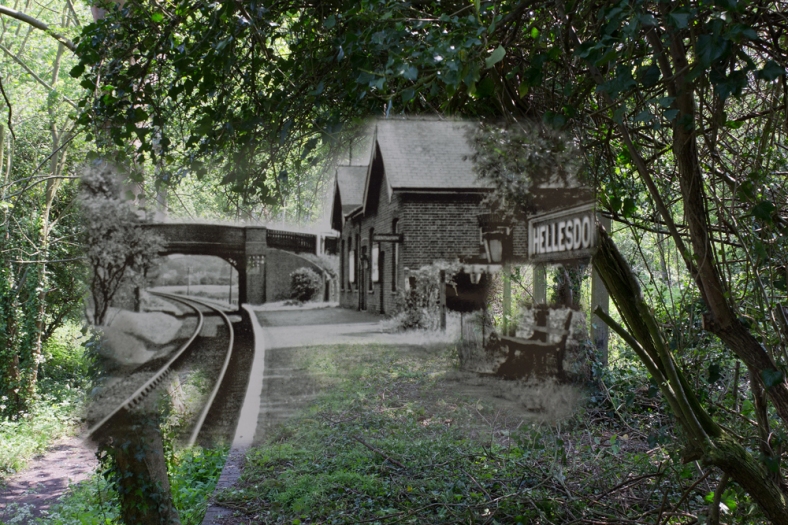
And again after the tidy-up.
A little bit of fun, just to bring the Drayton A-Frame back to life.
The former Drayton Station, now an Industrial estate.
The Station building from Station Road.
Looking back across Drayton from the Taverham Road.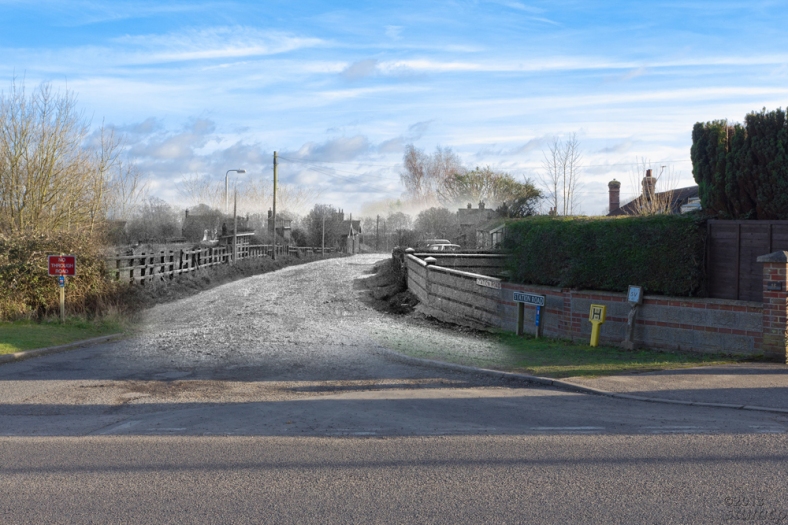
Looking back at Drayton through the long-demolished Taverham road bridge.
The countryside makes way for industry just after Attlebridge.
The Atlas Concrete Works close to Lenwade.
We meet that final ‘special’ again, this time at Lenwade Station.
Next up is a closed Whitwell. The line only open for the concrete coming out of Atlas.
Whitwell and Reepham’s recently rebuilt signal box.
Looking back towards Norwich from Whitwell’s signal box.
At Themelthorpe a new line curves eastwards. The former M&GN track-bed on the left.
The Norwich line as it comes into Melton Constable.
Looking back in to Melton Constable from the east.
A loco and its train approaches the platforms past Melton East signal box.
A loco on the Yarmouth line heading out from the platforms.
Another loco approaching from the platforms from the East.
A freight loco heads East away from the platforms.
A Diesel awaiting to depart East from the platforms.
The perfect house for railway enthusiasts, Melton Constable.
Looking West from the main platform at Melton.
The Mason family sat in the Melton Constable waiting room.
A Norwich train waiting at the Melton Constable platforms.
A later version of the same spot, this time with a steam special.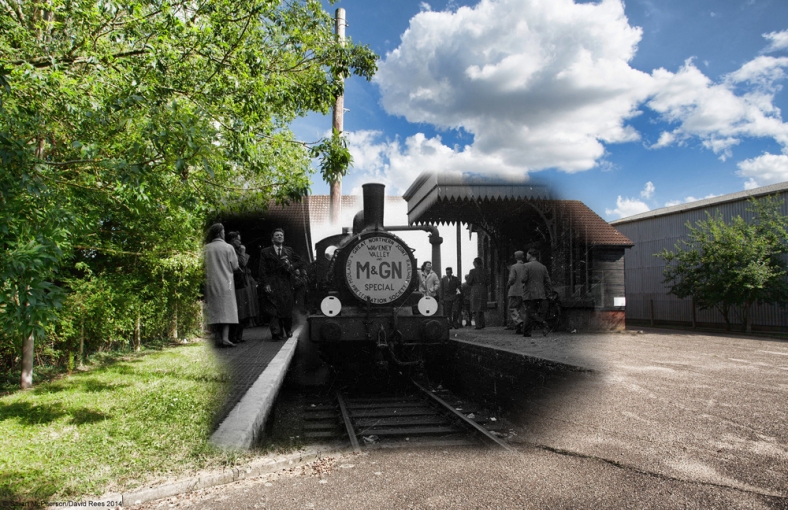
Looking back at the Station across the turntable.
And another look at the turntable from a non-existent bridge.
The BR Engine shed at Melton Constable.
Just north of Melton is the crossing at Briston.
The next station along the line was at Holt, now the A149.
Looking east at Holt towards what is now the North Norfolk Railway.
West of Melton Constable, a Fakenham-bound train heads through Piggs Grave.
Another train is heading back into Melton from Fakenham.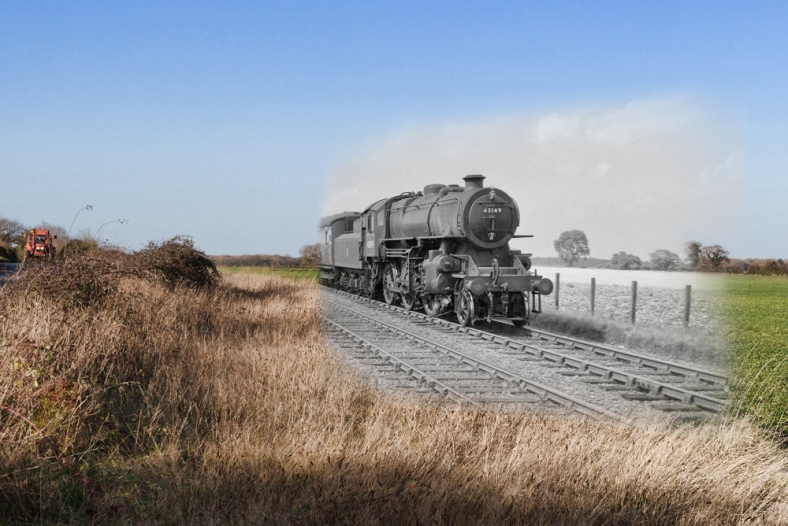
And another train pulls hard away from Melton towards Fakenham.
The line headed west and made its way to Fakenham (Now Jewsons).
Looking West from a missing bridge. This took some ingenuity on my behalf.
The M&GN Fakenham staff pose on the platform for a photographer that wasn’t me.
Heading East from Melton towards Yarmouth eventually brings you into M&GN Honing.
1950’s Passengers waiting for the next train out of North Walsham at Honing.
Looking towards Yarmouth, past Honing East signal box and crossing.
The M&GN makes its way to the coast, here it reaches Great Yarmouth.
A train heads North out of Yarmouth Beach Station and through later-added homes.
The site of the former Beach station is now just a car park.
Continuing the Coastal theme, some parts of the M&GN are still in use today. Cromer.
And at the now only-partially-used Runton Triangle.
A freight train from the past interrupts the Heritage operations at Sheringham.
Finally I make my way to Mundesley to confuse Bungalow dwellers of the future.
M&GN staff pose at Mundesley, but not for my camera.
And finally this fantastic driveway gate-crashing engine from the past.
I hope you’ll agree that the images have taken me on an epic journey across both time the Norfolk Countryside and that they offer a fascinating window into the past. The railways were one of the biggest innovations that helped to create the increasingly-small and very-connected world in which we now live, and often take for granted. Just think, a little over a century ago we were still travelling across the country on just foot or by horseback. It’s amazing how quickly we’ve advanced (whether that’s a good or a bad thing) since the railways spread their tendrils far and wide across not just the country, but the world. I find it equally amazing at how quickly the countryside reclaimed what had been taken from it by those Victorian pioneers and their steam-powered machines.
The full collection of M&GN Ghosts can be found in this Flickr album: Click me. If you know anybody who has any old images of the M&GN that they’d be willing to let me ‘Ghost’ for them, please do get in touch as I’m always looking to expand this collection and to continue satisfying my childhood obsession with an old path hidden behind Sloughbottom Park.
Thanks once again for reading,
Stu
This is Stupendous (forgive my pun)
Thank you so much for putting it all together. I now need a long train journey on which to read through it at leisure
LikeLiked by 1 person
Fascinating detail & great research. A marvellous trip down memory lane/ track. On a stormy winter day I was lost in another era.
LikeLiked by 1 person
You should contact the M&GN Circle which has a massive collection of photographs and in depth details of all aspects of gone but not forgotten line. Membership is only £15 a year which allows access to all artefacts and a 17 page monthly bulletin .
LikeLiked by 1 person
I’ve been in contact with them and offered up a book with them. No joy so far, although they did ask me to do a digital walk and talk through the ghosts at a recent gathering.
LikeLike
I found this really interesting. I still have family living in Melton Constable and as a small boy I still remember being taken by my parents on visits to see them via the train from City station.
My uncle was a driver on the M&GN steam engines and transfered after training to diesel rail cars.
My memories are a little cloudy these days but like you I am drawn to MGN especially the Norwich to Melton stretch.
No doubt after stumbling on brilliant site I will be revisiting from time to time.
Thankyou
Richard P
LikeLiked by 1 person
Hi Richard, thanks for the positive feedback. I don’t suppose there are any images of your Uncle at work? Did you see my group talking about Melton and Honing on Channel 5’s Walking Britain’s Lost Railways a year or so back?
LikeLike